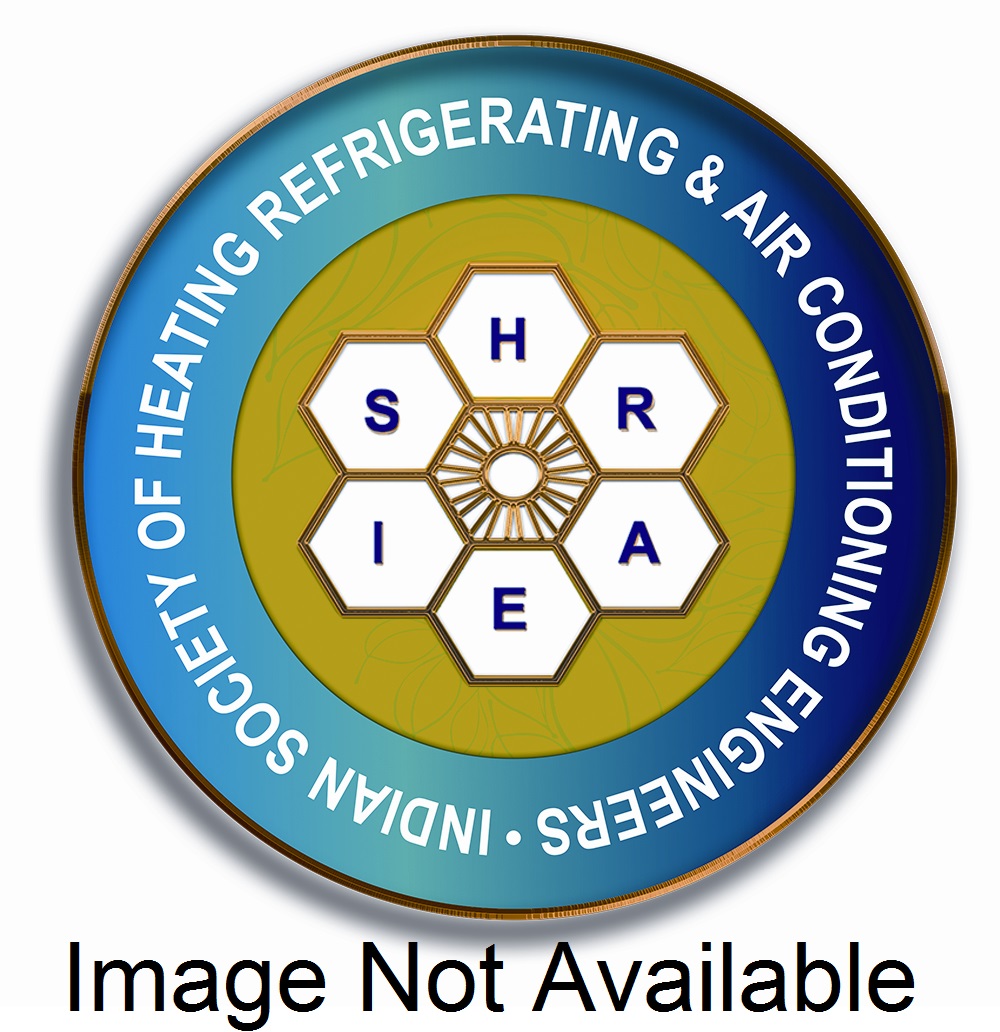By R.V.Simha
Advisor
Director, Airtron Consulting Engineers Pvt. ltd., Bangalore
I refer to the views expressed by K. Ramachandran in the Viewpoint column of the July-August 2015 issue of the Journal. It is not often that one sees such a studied and carefully composed write-up in response to a contribution, which in this case happens to be mine. It is most welcome. There has been a clamour for debates for quite some time on issues of crucial importance to our industry. That the kick-off has come from no less a person than K. Ramachandran, our National President, warrants a doubly warm welcome. It is now for the Journal – and more importantly ISHRAE itself – to make sure that such debates become a vibrant feature of its gamut of activities. ISHRAE’s progress, right from the time it came into being, has
been truly impressive. Member strength and geographic spread; the creation and growth of ACREX and the ACREX brand; the relationship with ASHRAE, other organizations and institutions abroad; the organization of seminars, workshops, product presentations and expositions; and publications may be listed amongst the aspects on which ISHRAE has been conspicuously successful. Designating the bullet points in Ramachandran’s Viewpoint as 1-4, points 1 and 2 represent a significant contribution to the achievement of these objectives. Publications and
expositions have indeed served ISHRAE well. The Journal and the handbooks have apparently been quite popular, though no data seem to be available. Regarding points 3 and 4, I am not personally aware of initiatives that have been taken and how effectively they are being implemented.
Following the bullet points that recapitulate ISHRAE’s objectives, Ramachandran takes notice of the key observations in my write-up under the column Viewpoint in the Journal (March-April 2015), and proceeds to respond to each of the 4 points. The nature and structure of ISHRAE membership is based on the ASHRAE model. The relations between ASHRAE and ISHRAE have been growing satisfactorily with this model backed up by ACREX and the ACREX brand. The opinion expressed that it would not have been appropriate for ISHRAE to ‘encourage’ ammonia no doubt
represents Ramachandran’s approach and views. However, this issue has been approached differently in several other countries including some in Europe like France and Germany, who have been using ammonia for several decades not only for cold storage, refrigeration and related industries, but also for air conditioning of built interiors. The interpretation of the word ‘encourage’ in the previous paragraph calls for some comments. ‘Encouraging’ does not mean making the concept mandatory. Encouraging is recommendatory. The usage of the word ‘encouraging’ for topics
like adaptive approach and passive cooling technology is only recommendatory. The emphasis is on creating awareness and ensuring that the requisite information is readily available. The word is used in this sense widely in the United States – including in ASHRAE publications and perhaps in most of the English speaking countries in the world without causing any confusion, particularly in lectures, presentations, seminars and workshops.
Continuing with ammonia, the question is not just whether it is a suitable refrigerant for refrigeration and air conditioning. What we need to look at is, whether encouraging or pushing ammonia is a ‘deliberate’ decision by a duly constituted committee of knowledgeable and competent members of ISHRAE after a comprehensive debate on its pros and cons, especially from the point of view of the requirement of our country. To my mind, the
question should be looked at afresh, for there could be substantial benefits in going for ammonia at a significantly larger scale. It is also necessary to study the process by which this kind of decision was taken, so that the process could be improved and made transparent. A similar view of the word ‘encourage’ can also be taken with regard to adaptive thermal comfort approach and indeed, for that matter, for all such issues. Adaptive approach figures in mainstream HVAC (msHVAC) also, in addition to passive cooling. (Passive cooling, it may be noted incidentally, does not permit
introduction of refrigeration under its umbrella and neither does Adaptive Approach; it is clearly stipulated in Standard 55, 2010 and its later versions.) Adaptive approach need not necessarily mean that it is used for the whole building. It could be a part of an MMS ASHRAE, for instance, includes adaptive comfort standards in Standard 55 itself. msHVAC is, therefore, under no threat from the adaptive approach. To quote from Ramachandran’s Viewpoint: “Advocacy does not even find mention in the Society’s (ISHRAE’s) stated objectives.” “Does ISHRAE really want to shape the thinking and policies of the Government?” The first sentence is unexceptionable. As for the second, the response would be yes – one vitally important
aim of Advocacy is to present views favoured by the Society to the Government so that they are factored into its thinking. There will, for sure, be other bodies, institutions, pressure groups and lobbies trying their utmost to influence the Government. Not to be forgotten are the lobbies of business and HVAC industry, which are extremely powerful stakeholders in our industry. ISHRAE’s advantage is that it is a third party and ‘not for profit’ organization. So, ISHRAE has no axe to grind, its only objective being to recommend what is good for the country in matters concerning HVAC engineering. Advocacy is a critical requirement. In ASHRAE, it is now under the charge of an Advocacy Executive Committee, which is currently
headed by its past president Dr. William Bahnfleth. Members of the Committee are seniors and well known in the industry and in ASHRAE as well. The Advocacy Executive Committee keeps doing an oversee of policy priorities (see ASHRAE website). Like ISHRAE, ASHRAE does not have the word ‘Advocacy’ directly anywhere in its ‘Mission’. Notwithstanding this, ASHRAE has gone about handling Advocacy seriously.In p78, column 2, para 4, we find another sentence: “There is no denying the fact that many members of ISHRAE do sit on policy forming bodies of the Government. Examples are committees formed by the Bureau of Energy Efficiency to formulate Energy Conservation Building Code, and the committee of Bureau of Indian Standards to formulate the revised National Building Code. However, these members either represent themselves or the organizations they belong to, and do not represent ISHRAE in these committees.” From this paragraph, it is apparent that some members are indulging in Advocacy on their own in their own way, and they do not owe any allegiance to ISHRAE. Under the circumstances, one wonders whom they represent. To add to the confusion, ISHRAE has in fact Advocacy Chairs at the national as well as chapter levels. This degree of confusion and contradictions are indeed extremely disappointing and disturbing. In respect of many of the items listed on which ISHRAE is active, the remark that could be made is – there is lack of information and assessment of eff ectiveness on the initiatives. This applies to training and certification programs, both at national and chapter levels; publication of handbooks and technical literature; standards development with regard to Indian weather conditions; Weather Data Book; student programs, industry visits, placement assistance and project funding; expert committees on topical issues such as Refrigerants, Indoor Environment Quality, Safety, etc.; and funding of select Research Projects. Item 7 – An International quality annual exhibition ACREX coupled with a student quiz program aQuest, and item 8 – Social and electronic media, website, Facebook pages, etc. are OK. Item 9 – Publication of this bi-monthly Journal – is one of the most valuable activities that ISHRAE has undertaken. However, diverse ideas, views, approaches and providing a
platform for debates on emerging issues could be facilitated more proactively. This approach and its implementation could be updated periodically, providing comments and helpful remarks and guidelines to emerging scenarios. A committee could be set up to oversee how eff etively the concept is working. Any new invention or innovation or systems and solutions need to be understood adequately before they are applied. It may call for educating and training of HVAC engineers. Normally, for the msHVAC industry, this is done within the industry through the manufacturers, system specialists, consultants and on-the-job learning. An institution like ASHRAE is, of course, a great facilitator and provider of such services. ISHRAE is
following the same path. In the case of the adaptive approach, adaptive comfort and passive technologies, the education to be imparted and accordingly the learning received are both difficult to ingest and digest, because HVAC engineers of today have not been exposed to the concepts and calculation procedures, which differ from those called for in msHVAC. Is it that the extra effort required to get familiar with the topic of adaptive approach and the nature of passive systems is an obstacle that has been posing problems to msHVAC? It ought to convince everybody that if the need for learning, education, training...... is acute from many considerations, the pressure from Advocacy can only add to it. Having contradictory views (p78, column 2, last para) is welcome. However, these views must be debated and analysed so that a consensus can be built. This ‘built view’ will be ISHRAE’s View and therefore, ISHRAE can take up a clear position. ISHRAE’s View must then be discussed with the officials in the concerned ministries. The views gathered from the contacts and discussions with the officials should be factored in while finalizing ISHRAE’s
View. The fi nal view should be duly put down in writing. The entire procedure could take a long time. Nevertheless, similar procedures are adopted elsewhere in the US and other countries to ensure that actionable decisions can be taken. The inescapable fact that the procedure takes long should, in fact, lead to starting as early as possible. The time consuming procedure should nevertheless be pursued as it is most likely to ensure the most
pragmatic and ideal results in the long term. The para that follows includes the sentence: “We are still a long way from perfection”; there is no disputing this observation. It can be taken to apply to all facets of ISHRAE activities, including even those that we proclaim as successful.
It is well-known that 15-20% membership activity is a very respectable figure (particularly for attendance at meetings) in organizations of our type. So, rather than concentrating on total membership, we should ensure that the number of active members is adequate and that they deliver. These numbers should include many interested, hard working, dedicated, senior members with adequate domain strength. The rest of the points listed by K. Ramachandran are unexceptionable, but the fact that they are required to be stated even after so many long years of activity is disturbing. ISHRAE’s brain tank should work overtime with dedication and unwavering focus to make this possible. Many of the points listed have been drawn attention to in several articles and presentations of mine; most of them have been published in the Journal.
Disclaimer: The information provided within this publication / eBook/ content is for general informational purposes only. While we try to keep the information up-to-date and correct, there are no representations or warranties, express or implied, about the completeness, accuracy, reliability, suitability or availability with respect to the information, products, services, or related graphics contained in this publication / eBook/ content for any purpose. Any use of this information is at your own risk.
 Youth
Youth
 Women
Women
 Research for Ishrae
Research for Ishrae







